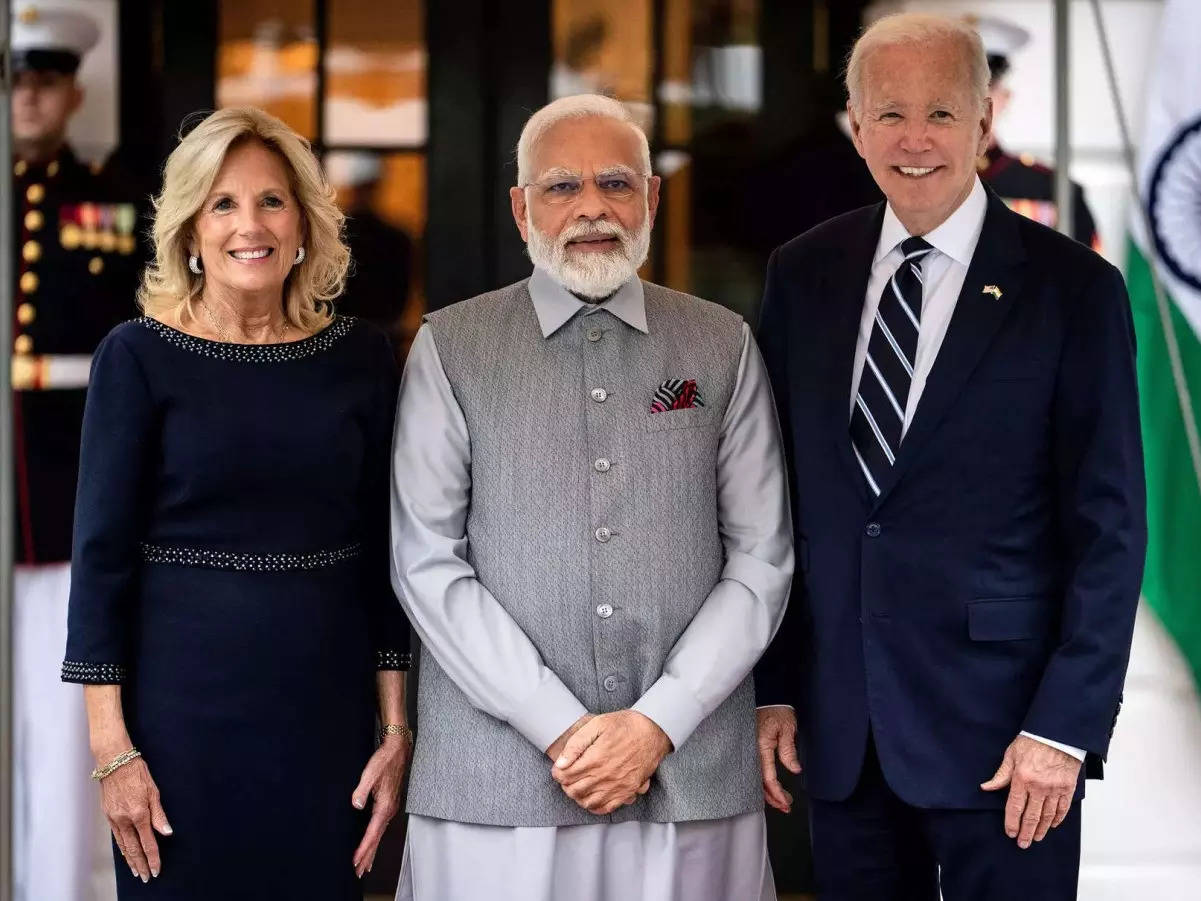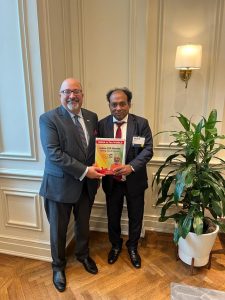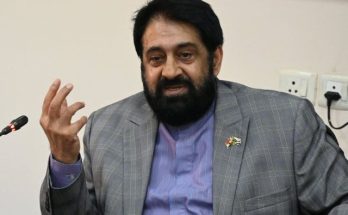WASHINGTON: Prime Minister Modi’s recent visit to the US culminated in transformational outcomes such as the pathbreaking jet engine deal, the transfer of sensitive critical technologies and the forging of next-generation defence partnership. Atul Keshap, who serves as the President of the United States India Business Council (USIBC), has played a key role in the ongoing transformation of the India-US relations. In this exclusive interview with Manish Chand, Editor-in-Chief, India and The World and Director, Centre for Global India Insights (CGII) at the USIBC office in Washington, Mr Keshap stresses that the US supports India’s aspirations, including a permanent seat at the UN Security Council, and is committed to accelerate the rise of India.
Excerpts from the interview:

Q) Prime Minister Narendra Modi’s visit to India is transformational and pathbreaking in many ways. Some say it’s the next big moment in India-US relations after the nuclear deal. How do you capture the significance of this visit by Prime Minister Modi?
A) It is hugely significant. Frankly speaking, it is about the future of the world over the next 20 years or more because what the United States and India agreed on this visit will carry forward in terms of preserving the peace and prosperity and stability and happiness of both the United States and India, and the entire world. So, we are Quad partners, we are increasingly accelerating our strategic, economic and technological convergence. We are rapidly expanding our technology partnership under the iCET umbrella. We are building up even more of that on the INDUS-X (India-United States Defence Acceleration Ecosystem) that we have hosted. So, this is not about today, this is about the next 20 years and the future of the world and planetary happiness.

Q) Upgrading and transforming defence partnerships is one of the major outcomes of Prime Minister Modi’s visit. USIBC hosted INDUS-X, a very innovative, pioneering move to bring together startups, Indian and US startups and defence startups. Taking a long-range view, what is the purpose of INDUS-X? How would it lead to the Indian defence industry moving up the value chain?
A) Well, as the old saying goes, a clairvoyant personplants seeds today for trees under which they may not be able to sit during their lifetime. I believe INDUS-X is precisely about planting those seeds, about identifying opportunities within the startup defence ecosystem of both our countries to support winners and ensure the long-term stability and happiness of our nations. We had some exceptional companies that showcased their technologies at the US Chamber. These technologies are cutting-edge, deep-tech, and futuristic, originating from both American and Indian companies. Our objective is to witness the thriving collaboration and development of the defence ecosystem, leading to the creation of platforms that will safeguard the freedom and happiness of Americans and Indians for many years to come. Therefore, once again, this initiative is centred around planting seeds and nurturing their growth into mighty oak trees.
Q) Some say that the focus on defence is obviously aimed at enhancing India’s deterrence, especially against China. Is President Biden trying to build India as a counterweight to an aggressive China? How do you look at that?
A) I disagree with the phrasing of the question. America, our great country, firmly believes in democracy as the most exceptional operating system for humanity. Therefore, America values and strives to support strong democracies worldwide. India, being the largest democracy in the world, represents a stable polity and is a responsible participant in the international system. It is also a rapidly growing economy, and the four million Indian Americans contribute significantly to strengthening the ties between our two nations. Thus, this matter does not involve any third country. Instead, it revolves around the objective of maximizing the strength of the United States and India in the post-pandemic world. During these challenging geostrategic times, we aim to demonstrate the immense power of our great democracies. By doing so, we safeguard our countries, our people, and our free and open societies. Moreover, we inspire and encourage other nations that share similar values.
Q) While discussing the expansion of trade and investment, you have frequently mentioned the aspirational figure of $500 billion in bilateral trade. Currently, the India-US bilateral trade stands at approximately $200 billion. When can we anticipate reaching the remarkable milestone of $500 billion? Furthermore, based on the momentum generated by PM Modi’s visit, can India anticipate a surge in American investment in the foreseeable future?
A) My guruji says, “Realise, realise, and visualise.” Therefore, when I speak about the goal of $500 billion, I want to emphasise the urgency of realising that target. I urge both of our governments to take necessary steps to foster the growth of trade and investment in both directions. Trade, as the old joke goes, is like dating, and investment is like marriage. The marriage between our two countries, I believe, is a potent force that comes with investment flowing in both directions. I desire a framework where both governments can swiftly and eagerly develop structural agreements to enable our companies to thrive and prosper. This includes agreements such as the Digital Services Agreement, Investment Agreement, and Semiconductor and Electronics Manufacturing Agreement. These agreements will impact digital trade, fintech, and various other sectors, ensuring that companies from both the United States and India have a structure and framework to flourish and stimulate trade and investment up to the $500 billion level. With India’s rapid growth and the imminent achievement of becoming a $5 trillion economy, followed by $10 trillion and $20 trillion, it is inevitable that our trade will expand. Therefore, I assert that $500 billion is not a mythical figure; in fact, we should be aiming for $1 trillion. We should nurture a deep ambition because it is beneficial for both countries and the entire world. I implore both governments to be as impatient as I am in pursuing this goal, as I believe it will truly unite our people and serve as the binding force for our nations.
Q) USIBC has also spearheaded iCET, another pioneering move by the two countries. iCET is focused on the transfer of sensitive critical technologies, which was a major focal point during Prime Minister Modi’s visit as well. Looking ahead, what kinds of critical technologies can India expect to gain access to in the coming days?
A) Well, let me defer to both the governments on that, particularly to the US government. Technology is clearly the strong point for both of our innovation societies, and we realise that because we trust each other and have been through this pandemic together as brothers and sisters, we now need to intensify US-India technology cooperation in all the ways that will define the world in the future. So again, this visit is not about today; it is about the next 20 years. Semiconductors, secure telecoms, artificial intelligence, quantum computing, defence – which we are working on today in Indus-X here in the Chamber – and so many of these deep tech and future tech fields are really critical. It is critical that the great democracies lead in these areas. If we don’t lead, countries that don’t share our operating system and our values will ultimately lead to the subjugation of free people everywhere.
So, for the US and India to intensely focus on technology is great, and I welcome it. I am delighted that the USIBC is able to play a part in advancing that. Our member companies are very excited about the iCET and Indus-X and what they mean for our collaboration. What specifically will be agreed upon, again I defer to the governments, but I think one thing is certain: in all of my conversations that I have had with the White House and with the Indian system, both governments are ambitious, both governments are positive, both governments believe in one another. There is a high degree of trust and confidence, and there is a strong sense of strategic, economic, and technological convergence, along with a shared purpose.
Q) Going beyond bilateral issues, the India-US partnership has a global canvas, and we collaborate closely in multilateral forums and on cross-cutting issues like climate change. As you know, India is currently holding the G20 presidency. Where do you think the synergies lie? How can President Biden help ensure a successful Indian presidency of the G20?
A) India has had a very successful G20 presidency, and they have shown how the very encouraging work by India to empower the citizen, especially through digital tools, has been a great model for countries all around the world that are struggling to lift their people up to new levels of prosperity and happiness. I think about how India has completely transformed in the past few years in terms of citizens’ access to the banking system, credit, things like sanitation, roads, electricity, education, and healthcare. The changes in India have been sweeping in the past decade and are really impressive. And a lot of that has been based on digital tools like UPI and Aadhar Card and how they unlock all these government services for the people. That kind of model, which India is talking about in its G20 presidency, is a great model for India and the world, and many countries can derive benefit from it.
So, from the US perspective, these are all positive things, and I think Americans appreciate and applaud what India has done to transform the lives of its citizens. And having an Indian 5G stack or 6G stack is going to be something that protects citizens’ rights and freedoms. It’s not like certain other 5G stacks that are deeply worrisome in terms of citizens’ privacy and their ability to enjoy their freedoms.
So, people in America feel really good about what India is contributing to the world, and through the G20, India is spotlighting those things. So, I think we are very supportive. India can speak to the US government about their views, but from the view of just myself and the companies I represent, many of these things are areas where American companies and Indian companies can work very productively together to amplify these platforms that India has developed.
Q) The anthem of India’s G20 presidency is “Vasudaiva Kutumbakam,” which means “the whole world is one family.” I think the larger point here is that India is trying to position values at the heart of its G20 presidency and global multilateral diplomacy. How do you view the importance of values? Is it something that sounds idealistic, or is it time to prioritise values in multilateral diplomacy, diplomacy as a whole, and the way things are being done?
A) As someone who has spent 30 years in the world of diplomacy, I would say interests are the true glue of any relationship. The United States and India have profound convergence on certain interests, especially in the Indo-Pacific and in the strategic realm. Beyond that strong glue and shared interests, values are important. I believe Americans love and respect India because Indians are free people, and India has a diverse, pluralistic, and democratic society. It is a pillar of democracy worldwide and has lifted hundreds of millions of people out of poverty through sustained development and economic liberalisation. These are things that Americans admire.
Americans appreciate the rise of India, and the fact that India has a $30 trillion economy does not worry us because the values and operating system are essentially the same. This is also why Indians have been highly successful in America, as they recognise and embrace those values in our country, allowing them to thrive. From my perspective, interests are very clear, and values are also evident. This means that we have a tremendous opportunity to positively shape the development of the world over the next 20-40-50 years.
Q) Many years ago, America made two promises to accelerate the rise of India, and this has been a recurring theme throughout successive presidencies. Regarding Prime Minister Modi’s visit and the future direction, what would the rise of India mean in practical terms, according to you? Will the US support us for a permanent seat? What is the way forward?
A) I have worked for the US government. I am a retiree, but the US has, in the past, officially stated its support for UN Security Council reform and has recognized India as a great democracy that could be part of the reform process. Personally, I believe that given how much India contributes to sustaining global order, having India on the UN Security Council would be a significant positive development.
The US has dedicated two decades to unlocking the immense potential of US-India relations and removing obstacles, and the nuclear deal, which I am proud to have worked on for over three years, has played a crucial role in improving US-India relations and India’s interactions with the world. Currently, we are working on various initiatives such as the possible delivery of jet engines and technology transfer. The final outcomes are yet to be determined, but these efforts demonstrate the United States’ commitment to further strengthening the US-India relationship and enhancing defense collaboration for the future.
Our involvement in Indus-X exemplifies our aim to foster even deeper defence collaboration between the US and India, empowering India to become a strong and influential player alongside the United States throughout the 21st century, protecting its people, and contributing to global security. The American system, President Biden, and previous administrations have made substantial investments to ensure India’s rise as a $30 trillion economy. During times of need, we have swiftly provided assistance and aid to India, as was evident during our pandemic crisis in 2020 when India promptly sent pharmaceutical aid to the United States. This exemplifies the actions of true friends, highlighting the strength of our bond and why our two democracies will shape the future of the world.

- Ambassador (ret.) Atul Keshap serves as the President of the United States India Business Council at the US Chamber of Commerce. TPrior to that, he served as the Principal Deputy Assistant Secretary of State for the Bureau of East Asian and Pacific Affairs. In this capacity, he had policy responsibility for US relations with eleven countries in Southeast Asia and played a key role in leading the bureau’s response to the COVID-19 pandemic, both domestically and overseas. Throughout his 28-year career as an American diplomat, Ambassador Keshap has served in various postings, including India, Morocco, and Guinea. He has also served as the United States Ambassador to Sri Lanka and Maldives.
- Manish Chand is CEO, Centre for Global Insights India, a think tank focused on global affairs and India Writes Network. He is Editor-in-Chief, India and the World, a journal on international affairs.
Author Profile

- Manish Chand is Founder and Editor-in-Chief of India Writes Network (www.indiawrites.org) and India and World, a pioneering magazine focused on international affairs. He is CEO, Centre for Global India Insights, an India-based think tank focused on global affairs.
Latest entries
 In ConversationNovember 26, 2025G20 is a Force for global Good
In ConversationNovember 26, 2025G20 is a Force for global Good articlesNovember 26, 2025Rescuing G20 from North-South divide: Ubuntu Moment
articlesNovember 26, 2025Rescuing G20 from North-South divide: Ubuntu Moment India and the WorldOctober 27, 2025Modi hails the century of India and ASEAN, backs ASEAN centrality
India and the WorldOctober 27, 2025Modi hails the century of India and ASEAN, backs ASEAN centrality India and the WorldOctober 26, 2025Act East: Five reasons why ASEAN summit in Malaysia matters
India and the WorldOctober 26, 2025Act East: Five reasons why ASEAN summit in Malaysia matters








